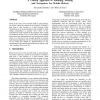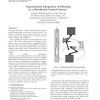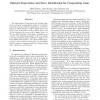AMS
2007
Springer
14 years 3 months ago
2007
Springer
Abstract In legged systems, springy legs facilitate gaits with subsequent contact and flight phases. Here, we test whether electrical motors can generate leg behaviors suitable for...
AMS
2007
Springer
14 years 3 months ago
2007
Springer
When an outdoor mobile robot traverses different types of ground surfaces, different types of vibrations are induced in the body of the robot. These vibrations can be used to learn...
AMS
2007
Springer
14 years 3 months ago
2007
Springer
Navigation and application functionality of mobile robots rely on their collision-avoiding capabilities, also known as local navigation. We present the mobile robot ARTOS (Autonomo...
ISER
1989
Springer
14 years 3 months ago
1989
Springer
Many future applications of robotic systems will require manipulators to operate from moving vehicles. Such vehicles will be compliant in comparison to the rigid bases on which mo...
ISER
1993
Springer
14 years 3 months ago
1993
Springer
Much of the focus of the research effort in path planning for mobile robots has centred on the problem of finding a path from a start location to a goal location, while minimising...
ISER
1993
Springer
14 years 3 months ago
1993
Springer
This paper describes a complete system architecture integrating planning into a two-armed robotic workcell. The system is comprised of four major components: user interface, plann...
ISER
1993
Springer
14 years 3 months ago
1993
Springer
The interaction of an autonomous mobile robot with the real world critically depends on the robots morphology and on its environment. Building a model of these aspects is extremel...
ISER
1993
Springer
14 years 3 months ago
1993
Springer
In previous papers, I have argued that while parallel mechanisms are well known for their favorable structural properties, their utility is generally limited by an inherently small...
ICRA
1994
IEEE
14 years 3 months ago
1994
IEEE
While most previous work in planning manipulation tasks relies on the assumption of quasi-static conditions, there can be situations where the quasi-static assumption may not hold...
ICRA
1994
IEEE
14 years 3 months ago
1994
IEEE



